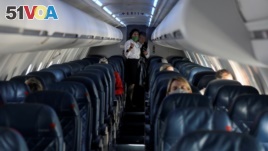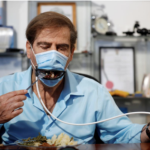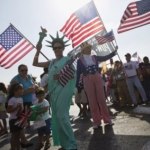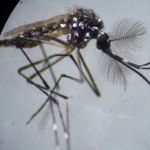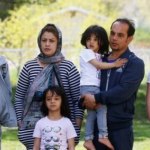For years, travelers have gotten used to low-cost flying on planes filled with passengers. But, like everything else, the coronavirus will change their expectations.
多年来,旅客们已经习惯了乘坐载满乘客的飞机廉价飞行。但是像其它所有事物一样,新冠病毒也会改变他们的期望。
Feng Xueli from Beijing took a flight within China recently. The airplane was full because it was permitted under Chinese rules.
来自北京的冯学礼(音译)最近乘坐了一趟国内航班。这架飞机坐满了乘客,因为这是中国的规定所允许的。
"We needed to wear a mask during the flight," he said. "You also need to go through a lot of temperature checks and security checks when you leave the airport."
他说:“我们在航班飞行途中需要戴口罩。在离开机场时还需要进行大量的体温检测和安全检查。”
Travelers, airlines and airports are dealing with the different rules put in place during the pandemic. The rules are different in almost every country.
旅客、航空公司和机场都面临着大流行期间制定的不同规定。这些规定几乎在每个国家都有所不同。
In Thailand, you cannot have food or water on the airplane and you must wear a mask. In Malaysia and Indonesia, the plane needs to be half-empty. In the United States and Europe, airlines are not required to leave the middle seat open. This means passengers cannot keep social distance.
在泰国,乘客在飞机上不能吃喝,而且必须戴上口罩。在马来西亚和印度尼西亚,飞机上必须留一半空座。在美国和欧洲,不要求航空公司将中间的座位留空。这意味着乘客们无法保持社交距离。
Subhas Menon is head of the Association of Asia Pacific Airlines. He said that it is not going to be easy to travel "because of all of the measures that are going to be introduced."
苏巴斯·梅龙是亚太航空协会的会长。他说,由于即将采取的各种措施,出行并不容易。
The last time there were big changes in air travel was due to the 2001 attacks in the United States. Travelers "understood the security requirements that came after 9/11," said Boeing vice-president Mike Delaney. He added that international airlines need to work together to decide on the new rules for flying.
上一次空中旅行发生重大变化是由于美国2001年遭受的袭击。波音公司副总裁麦克·德莱尼表示,旅客们“理解911恐怖袭击之后的安全要求。”他还表示,国际航空公司需要共同努力以制定新的飞行规则。
Airline service is changing too.
航空公司的服务也在发生变化。
Business class meals were once a reason to pay for the higher level of service. Now, those meals are not much better than economy class as airlines such as Emirates, Air Canada, and British Airways cut costs. And Qantas Airways now ask passengers to check in online to limit contact with employees and other fliers.
商务舱餐食曾经是付费获得更好服务的原因之一。现在,这些餐食并不比经济舱好多少,因为阿联酋航空、加拿大航空、英国航空等航空公司都在削减成本。澳大利亚航空现在要求乘客在线办理登机手续,以限制乘客与该公司员工及其它乘客的接触。
Empty Middle Seat?
中间座位留空?
On the airplane, one of the biggest questions has been whether the middle seat should be empty.
在飞机上,最大的问题之一是中间座位是否应该空着。
That means airlines would only fill 65 percent of the seats on a plane with passengers - not enough to make money without increasing the cost of the seats.
这意味着航空公司只有65%的座位可以坐人,在不提高座位费用的情况下不足以盈利。
Afif Zakwan recently took a Malaysia Airlines flight within the country that was not required to fly half-empty. He said he was not worried while on a short, in-country flight, but he would not fly internationally for now.
阿菲夫·扎克旺最近乘坐了马来西亚航空公司的国内航班,这趟航班不要求留半数空座。他说,在国内短途飞行他并不担心,但是他暂时不会坐国际航班。
Some nations are setting rules just for airlines registered in their country, while others are setting them for all international airlines.
一些国家仅针对在本国注册的航空公司设置规则,而另一些国家则对所有国际航空公司设置规则。
U.S. airlines are among those requiring passengers and crew to wear masks. They have also said they will make temperature checks.
美国的航空公司也要求乘客和机组人员戴口罩。他们还表示将会检测体温。
In Europe, airlines mostly decided not to leave the middle seat empty. But they have made other changes they hope will keep passengers from worrying about coronavirus.
在欧洲,大多数航空公司决定不将中间座位留空。但是他们做出了其它改变,希望这些改变能让乘客们不担心新冠病毒。
It is hard to social distance on an airplane, Finnair Chief Executive Topi Manner told Reuters. He added that health risks can be lowered by requiring passengers to wear masks.
芬兰航空首席执行官托皮·曼纳对路透社表示,在飞机上保持社交距离很难。他还表示,要求乘客戴口罩可以减少健康风险。
I'm Susan Shand.
我是苏珊·尚德。(51VOA.COM原创翻译,禁止转载,违者必究!)

